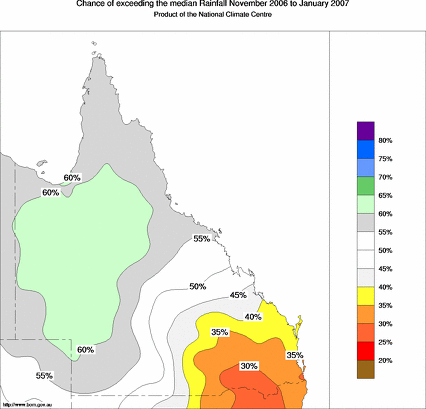| Qld Seasonal Rainfall Outlook: probabilities for November 2006 to January 2007, issued 26th October 2006 | |
Wetter in the northwest, drier in SE QldThe latest seasonal rainfall outlook issued by the Bureau of Meteorology, shows a mixed pattern of odds for exceeding the median rainfall over the late spring to mid-summer period (November-January). Drier than normal conditions are indicated for SE Queensland, whereas above average three-month totals are favoured in the west and north of the State. The pattern of seasonal rainfall odds across Queensland is a result of higher than average temperatures in both the Pacific and Indian Oceans. The warm Pacific biases the climate towards drier than average in eastern areas, but the warm Indian Ocean is associated with wetter than average conditions across the tropics. 
The chances of exceeding the median rainfall for the November to January period, are between 30 and 40% over southeast Queensland, with an area on the NSW border having 25 to 30% chances. These probabilities mean that BELOW median falls have about a 60 to 75% chance of occurring. So in years with ocean patterns like the current, about six or seven November to January periods out of ten are expected to be drier than average in these parts of Queensland, with about three or four out of ten being wetter. In contrast, an area covering parts of north and west Queensland has a 60 to 65% chance for the three-month rainfall total to exceed the long-term median. This equates to six seasons being wetter than average and four drier for every ten years with ocean temperatures similar to the present. Outlook confidence is related to how consistently the Pacific and Indian Oceans affect Australian rainfall. During the November to January period, history shows this effect to be moderately consistent across much of Queensland (see background information). The Southern Oscillation Index (SOI), negative for the fifth straight month, rose from −16 in August to −5 in September. The approximate SOI for the 30 days ending 23rd October was −14. The current El Niño conditions, of which the low SOI is but one indicator, are very likely to persist for the rest of 2006, which would qualify it as an official El Niño event. For routine updates and comprehensive discussion on the latest data relating to El Niño, together with details on what the phenomenon is and how it has affected Australia in the past, please see the ENSO Wrap-Up. | |
Click on the map above for a larger version of the map. Use the reload/refresh button to ensure the latest forecast map is displayed. | |
| More information on this outlook is available from 9.00am to 5.00pm (EST) Monday to Friday by contacting the Climate and Consultancy section in the Bureau's Brisbane Office: (07) 3239 8660. | |
THE NEXT ISSUE OF THE SEASONAL OUTLOOK IS EXPECTED BY 23rd NOVEMBER 2006 Corresponding temperature outlook | |
Background Information
|









